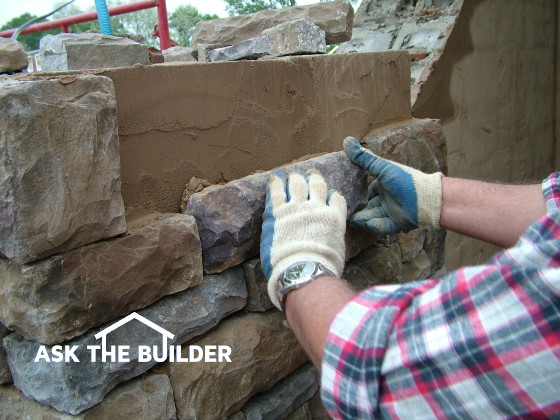Manufactured Stone Installation

The stone mason is working with wet mortar and buttered the piece of stone well before he pressed it in place. PHOTO CREDIT: Tim Carter
DEAR TIM: Soon I am supposed to have some manufactured stone installed on my house. But I must say I am a little concerned. A new house in my subdivision had it installed recently and after three months, 10 percent of the stones have popped off the wall. That makes me think the product is defective. Should I change to a different material? What do you think happened? Roger P., Kansas City, MO
DEAR ROGER: The popular manufactured stone materials are almost all Portland cement based products. The best and most good looking stones are highly sophisticated poured concrete products that are made using special molds and high-quality long-lasting permanent pigments. Even lower quality manufactured stone is still simply a mixture of sand, small stones, cement and pigments. As for defective product, I would only suspect this if the actual stones themselves were soft and crumbled easily.
If we had video tape footage of the workers installing your neighbor's stone and some past weather data, I suspect we would quickly discover what went wrong. My instincts tell me the error was 99 percent workmanship related, not product failure.
How is manufactured stone installed?
Manufactured stone is glued onto the vertical surface of a home as opposed to natural stone which is set on top of one another. Traditional stone is stacked and gravity pushes down on each stone. Manufactured stone is typically adhered to a wall surface with a cement stucco mixture that is often very rich in Portland cement.
The process of installing manufactured stone is not too different from the way traditional cement stucco is applied to the side walls of a home. With traditional stucco, several layers of wet stucco are applied and troweled to the desired finish. The wet stucco is a mixture of sand, Portland cement and sometimes other ingredients such as lime or latex modifiers. Once dry, the stucco is as hard as rock. With manufactured stone, the hardening process happens at the factory instead of the jobsite. The mason simply uses a stucco mixture to glue the manufactured stones to the house.
What could have gone wrong with the stone installation?
In your neighbor's case, any number of things could have gone wrong. The stucco mixture the contractor was using may have been mixed wrong. It might have had too little Portland cement in it. The stucco mix could have sat around the jobsite too long after being mixed. It could have started to harden on the mortar boards. If the contractor then tried to breathe life in this spent stucco mix by retempering it with water, this would have made a very weak bonding stucco.
The wall surface onto which the stones were set could have been dusty. The actual manufactured stones could have been dusty, too hot or too dry. It often helps if the back surface of the stones is slightly damp when the stucco mix is applied. If the stones are too hot and dry, they can suction too much water from the stucco mix too quickly. If this happens, the stucco mix never achieves its design strength.
Were the manufactured stone's instructions followed?
I can tell you for a fact that if the manufactured stone is applied per the manufacturer's instructions, it should stay on the side of your house for many years. If done right, I can see no reason why it couldn't last for hundreds of years. Cement stucco that is properly mixed and applied can last for hundreds of years with ease. Keep in mind that the stucco mix used with manufactured stone is hidden for the most part from the harsh weather elements. The manufactured stone takes the brunt of the wear from the weather. If your contractor takes the time to mix the stucco correctly and apply it while it is fresh, you should have no problems whatsoever.
If you really want the manufactured stone to stick to a home like epoxy, you can add one small step to the process. Typically the stone is applied to a surface that already has a layer of rough cement stucco or it can even be a concrete block wall.
CLICK or TAP HERE to get FREE QUOTES from local companies that will install your manufactured stone so it will last for years.
Once all materials are set up and the stucco is mixed, mix a batch of Portland cement paint. This is simply Portland cement powder mixed with pure water until it is the consistency of thin gravy. Dampen the surface of the wall slightly and the back of the stone. Use a brush to apply a very thin layer of the cement paint to the wall surface where the stone will be placed and to the back of the stone. Immediately butter the back of the stone with the stucco mixture and place the stone on the wall. Hold the stone in place for 10 seconds.
The cement paint works because it forms millions of microscopic interlocking crystals between the stone, stucco and wall surface. The stucco creates its own crystals, but the cement paint just adds even more bonding power. The cement paint is simple to apply and will permanently lock the stones into position.
Column 570